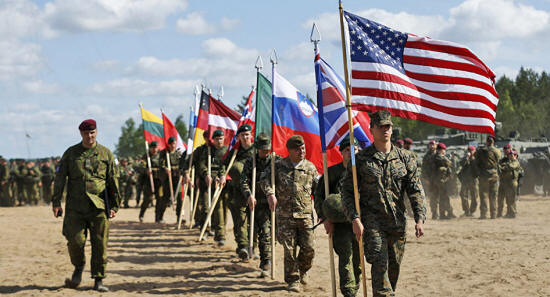|

24 June 2017
from
SputnikNews
Website

© AP Photo
Mindaugas Kulbis
According to secret documents obtained by a Russian intelligence
service, following the collapse of the Soviet Union, NATO planned to
split Russia into several smaller parts, a former secret agent told
Russia's
Rossiya 1 broadcaster.
After the collapse of the USSR, NATO planned to divide Russia into
small parts diminishing the state to the size of the medieval Moscow
principality, a veteran of the Russian "illegal" intelligence
service
said during the Vesti v Subbotu
("News on Saturday") program of Russia's Rossiya 1 broadcaster.
The program was dedicated to the 95th anniversary of the
Directorate S ("illegal" intelligence service) of the Foreign
Intelligence Service of the Russian Federation (SVR).
The interview was conducted by Vesti v Subbotu anchor
Sergei Brilev.
The voice, face and name
of the former agent were changed due to security reasons.
"Pavel Andreyevich
[the agent's alias] says that the NATO documents obtained by him
signaled that the dissolution of the USSR was only the first
stage," Brilev noted.
"And then [NATO planned] to create the Russian North-Volga
Republic and then the Middle Volga Republic, and reduce the
Russian state to the level and size of the Moscow principality,"
the intelligence veteran specified.
"We have these documents, they are now in the archive of our
[Russian intelligence] service," the former agent stressed.

US navy marines take a break
during annual recurring multinational,
maritime-focused NATO exercise
BALTOPS 2017,
near Ventspils, Latvia, June 6, 2017.
The idea of the partition of Russia is not new.
In his book
The Grand Chessboard
published six years after the collapse of the USSR, a
former US national security adviser and geostrategist,
Zbigniew Brzezinski, insisted
that,
"a more decentralized
Russia would be less susceptible to imperial mobilization."
"A loosely confederated Russia - composed of a European Russia,
a Siberian Republic, and a Far Eastern Republic - would find it
easier to cultivate closer economic regulations with Europe,
with the new states of Central Asia, and with [East Asia], which
would thereby accelerate Russia's own development," the
geostrategist claimed.
"Each of the three confederated entities would also be more able
to tap local creative potential, stifled for centuries by
Moscow's heavy bureaucratic hand," he added.
Interestingly enough,
before Brzezinski, the idea to sever Russia along the Ural Mountains
thus dividing it into "European" and "Asian" (Siberia and the Far
East) parts, was mulled over by Nazi Germany and its allies.
In December 1941, half a year after Nazi Germany invaded the USSR,
the Empire of Japan offered Adolf Hitler and Italian dictator
Benito Mussolini to divide Eurasia into two spheres of
interest along the 70th meridian east longitude.
As observers noted,
Hitler didn't plan to seize much of Soviet territory east of the
Ural Mountains.
More than a decade before the Axis powers of Germany, Italy
and Japan considered the partitioning of Russia, the territory of
the former Russian Empire was subjected to Allied intervention, a
multinational military expedition launched during the Russian Civil
War of 1918 by major European powers which backed the
anti-Bolshevik White Guard.
-
The United States
-
Canada
-
Japan
-
China,
...took part in the
intervention campaign along with European powers occupying Russia's
northwestern regions,
-
Crimea
-
Bessarabia
-
Siberia
-
the Far East
However, their efforts
were thwarted by divided objectives, a lack of domestic support,
war-weariness largely caused by World War I and the military
successes of the Red Army.
As history shows, each time Russia faced severe domestic and
geopolitical challenges it ran the risk of falling prey to the
global power game.
And U.S. bureaucrats
claim that Russia is 'aggressive'...
|



